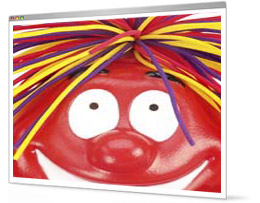My UPD8
You need to login before you download the free activities. You can register here.
- The Centre for Science Education
- The Association for Science Education
- Partners
- Part of ASE online
The science behind the nose

Type: Activity
Learning Strategy: Information retrieval
Topic: Light
Red Nose Day is coming! This activity focuses on red – why do things look red? Why are red noses shiny? More than half of Red Nose Day funds end up in Africa, so this activity also highlights some of the science happening across the continent – from armyworm killers to metals for mobiles; from satellites to methane-rich lakes. Students can plan (and give!) an assembly based on the Science Behind the Nose, or use the information and explanations to prepare a TV programme.
Published: 2nd March 2005
Reviews & Comments: 6
Learning objectives
� Students will reinforce their understanding of why things appear coloured and why things look shiny or dull. They will also remind themselves what happens when solids dissolve in water.
� Students will know about some of the science happening in Africa.
Try the activity
- activity_rednose.pdf
Downloaded: 3488 times - teachers_rednose.doc
Downloaded: 1849 times
You will need Acrobat Reader installed to open the activity sheets.
Curriculum link
� 8k light – explain the origin of colour in the dispersion of white light; give an example of how colour is important in everyday life; describe how light is reflected at plane surfaces� 7h solutions – use the particle model to explain what happens when solids dissolve in water
Running the activity
Suggested time: 20 minutes.
Possible starter:
Ask students if they can explain why red noses look red.
Main activity:
Show page 1 – either projected or as an OHT. The page poses five questions – four based on the colour red; one about science in Africa. Put students into groups. Ask them to use the information on pages 2 and 3 to work out answers to the questions on page 1. Alternatively, ask each group to work out the answer to one question. Groups can then plan an assembly or TV programme to present their answers in a fun and engaging way.
The information on page 2 does not directly answer the questions – students will need to process the information and apply it to different situations. Page 3 describes several African science initiatives – from Tanzania, Rwanda, Democratic Republic of Congo, Nigeria and South Africa. You could ask students to find out more about each of these initiatives using the weblinks below.
Plenary:
Ask some of the groups to present their assemblies or TV programmes to the rest of the class.
Web links
News links
- Red Nose Day 2005
- This is the official Red Nose Day site. It has lots of suggestions for the day, as well as (non-science) lesson plans
- Cell phone news
- This site summarises the story about coltan in the Democratic Republic of Congo. It highlights the some controversial and challenging issues in a reasonably accessible way.
- New Scientist
- This article tells the 'armyworm killer' story in more detail.
- New Scientist
- Read this article for more about the plans to use methane from Lake Kivu to generate electricity.
- New Scientist
- This tells the story of Nigeriasat-1, and emphasises the controversial nature of the project.
- The Guardian
- This fascinating article tells how two men transplanted the first human heart – the famous (white) Christian Barnard and his black colleague Hamilton Naki, who had to pretend to be a gardener.
Reviews & Comments
Write your online review to share your feedback and classroom tips with other teachers. How well does it work, how engaging is it, how did you use it, and how could it be improved?
metals reactivity
Mar 30th, 2009

I used the activity for my year 8 top set. They all managed to build up the reactivity series in one lesson.
The activity was very interesting and they managed to learn the word equations and managed to spot a pattern.
Reviewer: sue Elfons
Science
Jun 8th, 2008

another excellent resource from upd8!
Reviewer: Ghanniy Oyedele
light
Feb 20th, 2008

Excellent for re capping/reviewing light with year 9
Reviewer: kantha choudhury
Great activity to get them thinking
Oct 4th, 2006

My class really enjoyed this activity, as it's pretty straight forward and it gave them the chance to just get on with it without me leading the activity. I used this with a very high ability group and we all enjoyed the opportunity to get on with the task completely autonomously. It gave me a really enjoyable lesson, where I could spend a bit of time talking to the group as individuals, and it gave them a lesson where they could use the knowledge they already had to present information in a creative way. And I didn't even do it at the right time of year!
Reviewer: Amie Heaton
RED NOSE
Mar 9th, 2005

EXCELLENT ACTIVITY... MY CLASS COULD REALLY RELATE TO IT!
Reviewer: SABIYAH QADIR
Light Fantastic
Mar 4th, 2005

I used this activity with my year 10 class. A good resource. Thank you
Reviewer: Doris Evans

200 lessons and assessments from as little as £4.95
Related Activities
Physics / Light
QCA / 8K Light
Learning Strategy / Information retrieval
- Kidney stones
- Scratch proof
- Speedy sperm
- The short side of the family
- Goya: huge, hunted, and extinct
- Light fantastic
- Poo power or nuclear power?
- The Day After Tomorrow
- What's moving on Titan
- Formula One stays cool
- Ricin
- Firework Fun
- metals: fuels of the future?
- Godzilla is real!
- Just one Father Christmas?
- Healthy Eating
- Parched Summer
- Rooney's Foot
- World Cup Science Challenge
- Titan
- Hard Stuff
- Tour de Science
- Top 10 polluted cities
- Biodiesel